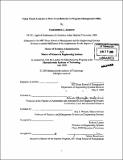Using visual analytics to drive lean behavior in program management office
Author(s)
Antoniou, Charalambos J. (Charalambos Jean)
DownloadFull printable version (15.26Mb)
Other Contributors
Leaders for Manufacturing Program.
Advisor
Deborah J. Nightingale and Roy E. Welsch.
Terms of use
Metadata
Show full item recordAbstract
Raytheon recently won a large order for one of its programs (Program X) leading to a doubling of monthly production. With a relatively larger order, Raytheon reduced the acquisition unit price to the customer. Thus, there is a burning platform to evaluate the current program assessment tools and ensure that the future assessment tools are adequate for a smooth production schedule. In addition, there is a need to create a more robust and automated manner of identifying risks and opportunities in the production process. The main approach is to use the Raytheon Six Sigma process (visualize, commit, prioritize, characterize, improve, and achieve) to solving major projects, which is similar to the original Six Sigma DMAIC process (define, measure, analyze, improve, control). Using the aforementioned process, this thesis explores whether introducing visual analytics and controls to the Program Management Office (PMO) can improve the overall communication between the PMO and the manufacturing work centers, and ultimately eliminate the various wastes and improve Program X's production process. In addition, this thesis examines if driving Lean behavior to the PMO, can indirectly drive Lean behavior across the manufacturing value chain leading to cost savings and increased productivity.
Description
Thesis (M.B.A.)--Massachusetts Institute of Technology, Sloan School of Management; and, (S.M.)--Massachusetts Institute of Technology, Engineering Systems Division; in conjunction with the Leaders for Manufacturing Program at MIT, 2008. Includes bibliographical references (leaf 73).
Date issued
2008Department
Leaders for Manufacturing Program at MIT; Massachusetts Institute of Technology. Engineering Systems Division; Sloan School of ManagementPublisher
Massachusetts Institute of Technology
Keywords
Sloan School of Management., Engineering Systems Division., Leaders for Manufacturing Program.